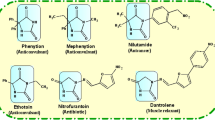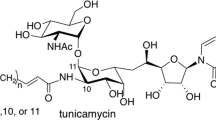Abstract
Recently we have synthesized a set of pyrimidine nucleoside derivatives bearing extended alkyltriazolylmethyl substituents at position 5 of the nucleic base, and showed their significant activity against Mycobacterium tuberculosis virulent laboratory strain H37Rv as well as drug-resistant MS-115 strain. The presence of a lengthy hydrophobic substituent leads to the reduction of nucleoside water solubility making their antibacterial activity troublesome to study. A series of water-soluble forms of 5-modified 2ʹ-deoxyuridines 4a–c and 8a–c were synthesized. They appeared at least two orders more soluble compared with the parent compounds 1a and 1b. Their half-hydrolysis time was 5–12 h, which can be considered optimal for prodrugs used in clinics. Obtained compounds showed moderate activity (MIC 48–95 µg·ml−1) against some Gram-positive bacteria including resistant strains of Staphylococcus aureus and Mycobacterium smegmatis and were low cytotoxic for human cell lines (CD50 >> 100 µg·ml−1).
This is a preview of subscription content, access via your institution
Access options
Subscribe to this journal
Receive 12 print issues and online access
$259.00 per year
only $21.58 per issue
Buy this article
- Purchase on Springer Link
- Instant access to full article PDF
Prices may be subject to local taxes which are calculated during checkout




Similar content being viewed by others
References
Brown ED, Wright GD. Antibacterial drug discovery in the resistance era. Nature. 2016;529:336–43.
De Clercq E, Li G. Approved antiviral drugs over the past 50 years. Clin Microbiol Rev. 2016;29:695–747.
Jordheim JP, Durantel D, Zoulim F, Dumontet C. Advances in the development of nucleoside and nucleotide analogues for cancer and viral diseases. Nat Rev Drug Discov. 2013;12:448–64.
Matsuda A, Sasaki T. Antitumor activity of sugar-modified cytosine nucleosides. Cancer Sci. 2004;95:105–11.
Yssel AEJ, Vanderleyden J, Steenackers HP. Repurposing of nucleoside- and nucleobase-derivative drugs as antibiotics and biofilm inhibitors. J Antimicrob Chemother. 2017;72:2156–70.
Bugg TDH, Kerr RV. Mechanism of action of nucleoside antibacterial natural product antibiotics. J Antibiot. 2019;72:865–76.
Thomson JM, Lamont IL. Nucleoside analogues as antibacterial agents. Front Microbiol. 2019;10:952.
Ferrari V, Serpi M. Nucleoside analogs and tuberculosis: new weapons against an old enemy. Future Med Chem. 2015;7:291–314.
Serpi M, Ferrari V, Pertusati F. Nucleoside derived antibiotics to fight microbial drug resistance: new utilities for an established class of drugs? J Med Chem. 2016;59:10343–82.
Shakya N, Garg G, Agrawal B, Kumar R. Chemotherapeutic interventions against tuberculosis. Pharmaceuticals. 2012;56:690–718.
Negrya SD, Efremenkova OV, Solyev PN, Chekhov VO, Ivanov MA, Sumarukova IG, Karpenko IL, Kochetkov SN, Alexandrova LA. Novel 5-substituted derivatives of 2ʹ-deoxy-6-azauridine with antibacterial activity. J Antibiot. 2019;72:535–44.
Shmalenyuk ER, Kochetkov SN, Alexandrova LA. Novel inhibitors of mycobacterium tuberculosis growth based on modified pyrimidine nucleosides and their analogues. Russ Chem Rev. 2013;82:896–915.
Van Calenbergh S, Pochet S, Munier-Lehmann H. Drug design and identification of potent leads against mycobacterium tuberculosis thymidine monophosphate kinase. Curr Top Med Chem. 2012;12:694–705.
Kögler M, Vanderhoydonck B, De Jonghe S, Rozenski J, Van Belle K, Herman J, Louat T, Parchina A, Sibley C, Lescrinier E, Herdewijn P. Synthesis and evaluation of 5-substituted 2ʹ-deoxyuridine monophosphate analogues as inhibitors of flavindependent thymidylate synthase in mycobacterium tuberculosis. J Med Chem. 2011;54:4847–62.
Kögler M, Busson R, De Jonghe S, Rozenski J, Van Belle K, Louat T, Munier-Lehmann H, Herdewijn P. Synthesis and evaluation of 6-aza-2ʹ-deoxyuridine monophosphate analogs as inhibitors of thymidylate synthases, and as substrates or inhibitors of thymidine monophosphate kinase in mycobacterium tuberculosis. Chem Biodivers. 2012;9:536–56.
Parchina A, Froeyen M, Margamuljana L, Rozenski J, De Jonghe S, Briers Y, Lavigne R, Herdewijn P, Lescrinier E. Discovery of an acyclic nucleoside phosphonate that inhibits mycobacterium tuberculosis ThyX based on the binding mode of a 5-alkynyl substrate analogue. ChemMedChem. 2013;8:1373–83.
Alexandrova LA, Chekhov VO, Shmalenyuk ER, Kochetkov SN, Abu El-Asrar R, Herdewijn P. Synthesis and evaluation of C-5 modified 2ʹ-deoxyuridine monophosphates as inhibitors of M. tuberculosis thymidylate synthases. Bioorg Med Chem. 2015;23:7131–37.
Khandazhinskaya AL, Alexandrova LA, Matyugina ES, Solyev PN, Efremenkova OV, Buckheit KW, Wilkinson M, Buckheit RW,Jr, Chernousova LN, Smirnova TG, Andreevskaya SN, Leonova OG, Popenko VI, Kochetkov SN, Seley-Radtke KL. Novel 5ʹ-norcarbocyclic pyrimidine derivatives as antibacterial agents. Molecules. 2018;23:3069–84.
Khandazhinskaya AL, Matyugina EC, Alexandrova LA, Chernousova LN, Smirnova TG, Andreevskaya SN, Leonova OG, Popenko VI, Kochetkov SN. Analogues of 5-substituted pyrimidine nucleosides as antibacterial agents. Biochimie. 2019. (In press).
Lorian V. Aminoglycosides and peptide antibiotics. In: Amsterdam D, editor. Antibiotics in laboratory medicine. 5th ed. Philadelphia: Lippincott Williams & Wilkins; 2005. p. 196–98.
Shmalenyuk ER, Chernousova LN, Karpenko IL, Kochetkov SN, Smirnova TG, Andreevskaya SN, Chizhov AO, Efremenkova OV, Alexandrova LA. Inhibition of Mycobacterium tuberculosis strains H37Rv and MDR MS-115 by a new set of C5 modified pyrimidine nucleosides. Bioorg Med Chem. 2013;21:4874–84.
Alexandrova LA, Shmalenyuk ER, Kochetkov SN, Erokhin VV, Smirnova TG, Andreevskaia SN, Chernousova LN. New 5-modified pyrimidine nucleoside inhibitors of mycobacterial growth. Acta Nat. 2010;2:84–9.
Huttunen KM, Raunio H, Rautio J. Prodrugs—from serendipity to rational design. Pharm Rev. 2011;63:750–71.
Srinivas NR. The rationality for using prodrug approach in drug discovery programs for new xenobiotics: opportunities and challenges. Eur J Drug Metab Pharmacokinet. 2011;36:49–59.
Jornada DH, dos Santos Fernandes GF, Chiba DE, de Melo TR, dos Santos JL, Chung MC. The prodrug approach: a successful tool for improving drug solubility. Molecules. 2015;21:42.
Abu-Jaish A, Jumaa S, Karaman R. Prodrugs overview. In: Karaman R, editor. Prodrugs design: a new era. 1st ed. Hauppauge: Nova Science Publishers Inc; 2014. p. 77–102.
Pochet S, Kansal V, Destouesse F, Sarfati SR. Alkylglycoside carbonates of 3′-azido-3′-deoxythymidine. Tetrahedron Lett. 1990;31:6021–24.
Lee BY, Park SR, Jeon HB, Kim RS. A new solvent system for efficient synthesis of 1,2,3-triazoles. Tetrahedron Lett. 2006;47:5105–09.
Levina AS, Tabatadse DR, Khalimskaya LM, Prichodko TA, Shishkin GV, Alexandrova LA, Zarytova VP. Oligonucleotide derivatives bearing reactive and stabilizing groups attached to C5 of deoxyuridine. Bioconjugate Chem. 1993;4:319–25.
Zarytova VF, Komarova NI, Levina AS, Lokhov SG, Tabatadze DR, Khalimskaya LM, Alexandrova LA. Synthesis of oligonucleotides containing C-5 modified deoxyuridine with an aliphatic amino group. Russ J Bioorg Chem. 1991;17:1059–65.
Alexandrova LA, Skoblov AY, Jasko MV, Victorova LS, Krayevsky AA. 2`-Deoxynucleoside 5`-triphosphates modified at α-, β- and γ-phosphates as substrates for DNA polymerases. NAR. 1998;26:778–86.
Khandazhinskaya AL, Shirokova EA, Karpenko IL, Zakirova NF, Tarussova NB, Krayevsky AA. P-(alkyl)-nucleoside 5ʹ-hydrogenphosphonates as depot forms of antiviral nucleotide analogues. Nucleosides Nucleotides Nucleic Acids. 2000;19:1795–804.
De Clercq E. Antiviral drugs: current state of the art. J Clin Vir. 2001;22:73–89.
Aleksandrova LA, Efremenkova OV, Andronova VL, Galegov GA, Sol’ev PN, Karpenko IL, Kochetkov SN. 5-(4-alkyl-1,2,3-triazol-1-yl)methyl derivatives of 2ʹ-deoxyuridine as inhibitors of viral and bacterial growth. Russ J Bioorg Chem. 2016;42:677–84.
Niks M, Otto MJ. Towards an optimized MTT assay. Immunol Methods. 1990;130:149–51.
Acknowledgements
The synthesis and the cytotoxicity studies were supported by the Russian Foundation for Basic Research (RFBR, projects 17-04-00536, 17-00-00395, 17-00-00393 and 18-29-08010). The physicochemical analysis of all compounds was supported the Program of fundamental research for state academies for 2013–2020 years (No. 01201363818). The authors are grateful to Dr R.A. Novikov (Engelhardt Institute of Molecular Biology RAS) for NMR investigations.
Author information
Authors and Affiliations
Corresponding author
Ethics declarations
Conflict of interest
The authors declare that they have no conflict of interest.
Additional information
Publisher’s note Springer Nature remains neutral with regard to jurisdictional claims in published maps and institutional affiliations.
Supplementary information
Rights and permissions
About this article
Cite this article
Negrya, S.D., Jasko, M.V., Solyev, P.N. et al. Synthesis of water-soluble prodrugs of 5-modified 2ʹ-deoxyuridines and their antibacterial activity. J Antibiot 73, 236–246 (2020). https://doi.org/10.1038/s41429-019-0273-x
Received:
Revised:
Accepted:
Published:
Issue Date:
DOI: https://doi.org/10.1038/s41429-019-0273-x



